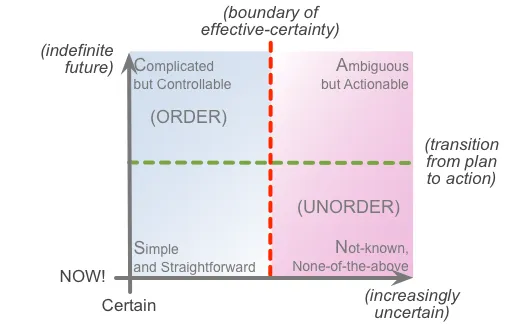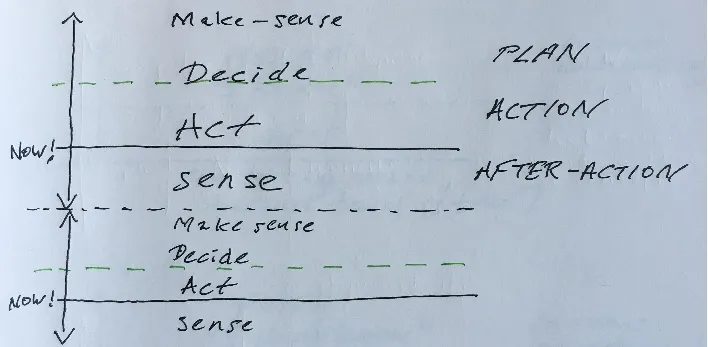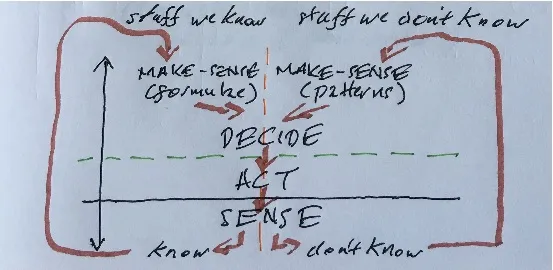Insights on SCAN: Rethinking OODA
Blog: Tom Graves / Tetradian
Yet another in this theme of insights about the SCAN sensemaking / decision-making framework that arose whilst working on clean-up for more general use of the tools in the inventory.
This time, it’s about a crossmap between SCAN and John Boyd’s well-known OODA model – Observe, Orient, Decide, Act:

Boyd’s initial context for OODA was in aerial combat, where the aim was to get one’s own decision/action cycle to run faster than that of one’s opponent – to ‘get inside their OODA-loop’, as the jargon puts it. And not just faster, but more accurately, as well – because that would tend to push the opponent into making mistakes, basing their decisions on conditions and contexts that no longer apply.
A key point here is that we can move OODA out from its literally combative origins, and generalise it to all manner of decision/action contexts. As we do this, it becomes more evident that there are nested cycles-within-cycles, tasks-within-tasks, much as we saw in the bubble-metaphor for SCAN and its worked-example of a surgical-operation:

In my own work I often prefer to reframe the OODA acronym somewhat, as Sense, Make-sense, Decide, Act (SMDA). This is because, in practice we do more than just ‘observe’ – we often need to sense out both what’s going in the outside world (outer-sense, ‘objective’), but also what we feel (inner-sense, ‘subjective’), and be clear about which is which. Likewise we often need to do more than just ‘orient’ ourselves in terms of what we’ve sensed: we’ll need to make sense not just of the known, but the unknown as well.
For most contexts, what we’re often most concerned about is the overall time of each entire cycle – which in turn is determined in part by the duration of each and any nested cycles:

To crossmap this to SCAN, we first note that the usual depiction of time in SCAN – the vertical dimension – is all about what happens before the ‘NOW!’, the moment of action:

But before it can loop back to that ‘before-action’ part, the full OODA / SMDA loop must also include the time needed to sense out what has happened – in other words, in the past, after that respective ‘NOW!’. When we crossmap this onto SCAN, we need to extend the time-dimension in SCAN to include not just a distinction between ‘plan’ and ‘action’ (above and below the green dotted-line), but an ‘after-action’ as well. In effect, this places the Sense part of a new SMDA cycle as the end-part of the previous cycle – which is also part of what links the cycles together:

(As an aside, note that this ‘after-action’ part of the cycle also maps closely to the ‘Performance’ phase of the Five Elements cycle – see the later part of the post ‘Towards a whole-enterprise architecture standard – 3: Method‘ for more detail on this. In fact, the two types of cycles – OODA / SMDA, and Five Elements – are closely related overall, and in some ways are functionally near-identical, as we’ll see in the next post in this series. For practical purposes, I’d tend to use the Five Elements for larger-scope or overview, versus OODA / SMDA when we get close to real-time action – in other words, cycles nested within the ‘Process’ phase within a Five Elements cycle. We can also crossmap SCAN to Five Elements, but given that we’re most likely to use SCAN to explore real-time concerns, the crossmap to OODA /SMDA is often the most useful here.)
If we now add to this picture the other dimension in SCAN – the horizontal dimension, about certainty and predictability, versus uncertainty and unpredictability – we get some solid insights about what actually needs to happen in that ‘orient’ or ‘make-sense’ part of the decision-cycle. Within the Sense phase of the cycle, we can split what we sense in terms of that certainty / uncertainty dimension, into ‘what I already know’ (certain) versus ‘what I don’t know’ (uncertain). Then, looping back to the start the ‘before-action’ part of the cycle, we can then feed those distinctions into the Make-sense phase, using already-known formulae for the sensings of the certain, and patterns and principles and the like to make sense of the uncertain:

A useful crossmap, I hope?
We might note that this also suggests that we’re likely to hit problems with our Decide and Act if we can’t distinguish between certain and uncertain, or if we don’t have any methods in place to make sense of the uncertain – which is what we’ll explore in the last part of this series.
Before then, though, would you have any thoughts on this? If so, do let me know in the comments below.